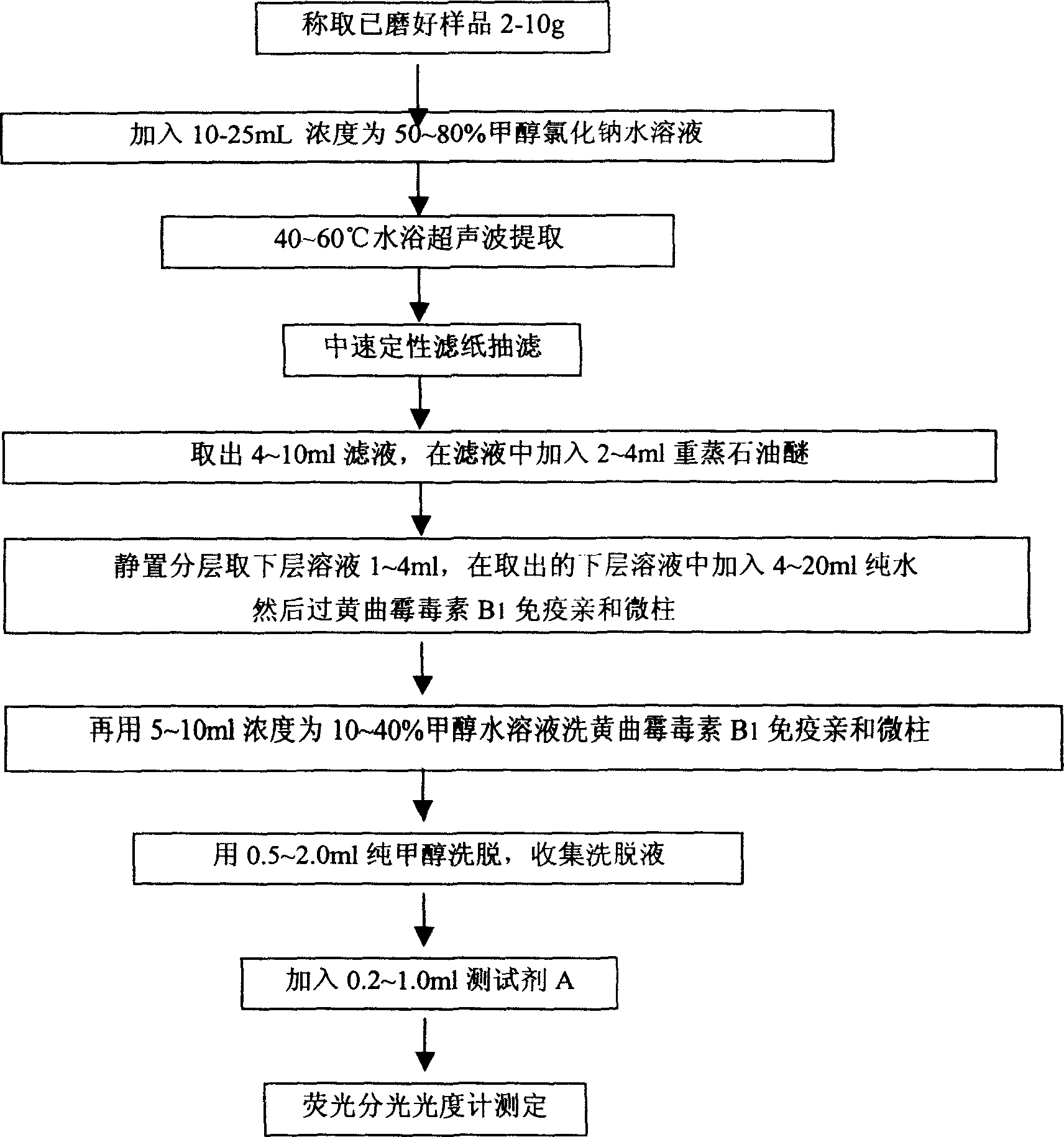Fast detecting method for aftatoxin B1
An aflatoxin and rapid detection technology, applied in measuring devices, instruments, scientific instruments, etc., can solve the problems of low detection accuracy, time-consuming, expensive instruments, etc., achieve less organic reagents and other toxic reagents, and improve specificity. High performance and sensitivity, separation efficiency and recovery
- Summary
- Abstract
- Description
- Claims
- Application Information
AI Technical Summary
Problems solved by technology
Method used
Image
Examples
Embodiment 1
[0016] Embodiment 1: take by weighing 10g ground rice sample and put into stopper test tube, add 20ml concentration and be 50~60% methyl alcohol sodium chloride aqueous solution, contain 1~2% sodium chloride by weight in the methyl alcohol sodium chloride aqueous solution, Ultrasonic extraction in a water bath at 50°C for 3 minutes, then suction filtration with medium-speed qualitative filter paper, and extract 10ml of filtrate; add 2 to 4ml of redistilled petroleum ether to the filtrate, shake and mix well, and take 4ml of the lower layer solution after standing for 2 minutes. Add 20ml of pure water to the removed lower layer solution, and then pass the aflatoxin B 1 Immunoaffinity microcolumns, the aflatoxin B 1 The specification of the glass microcolumn used in the immunoaffinity microcolumn is Φ2~4mm (inner diameter)×60mm (length), and each gram of amino-modified silica gel particles (microspheres) contains 1.0~3.0 mg of aflatoxin B 1 Polyclonal antibody; wash aflatoxin B...
Embodiment 2
[0017] Embodiment 2: take by weighing 8.0g ground Shandong big peanut sample and put into stopper test tube, add 25ml concentration and be 80% methanolic sodium chloride aqueous solution, contain 1.8% sodium chloride by weight in methanolic sodium chloride aqueous solution, in Ultrasonic extraction in a water bath at 60°C for 5 minutes, suction filtration with medium-speed qualitative filter paper, and 5ml of filtrate; add 3ml of redistilled petroleum ether to the filtrate, shake and extract, and after standing for 2 minutes, take 1ml of the lower layer solution, and add the lower layer solution taken out to 4ml of pure water, then aflatoxin B 1 Immunoaffinity microcolumn, wash aflatoxin B with 10ml concentration of 10% aqueous methanol 1 The immunoaffinity micro-column was eluted twice with 2.0ml of pure methanol, and the eluate was collected, and 1.0ml of test reagent A was added, and then measured by a fluorescence spectrophotometer. According to aflatoxin B 1 Fluorescenc...
Embodiment 3
[0018] Embodiment 3: take by weighing 2.0g vegetable oil sample and put into tool stopper test tube, add 10ml concentration and be 70% methanolic sodium chloride aqueous solution, contain 1.5% sodium chloride by weight in methanolic sodium chloride aqueous solution, in 40~60 ℃ water bath Medium-ultrasonic extraction for 3 minutes, suction filtration with medium-speed qualitative filter paper, and 8ml of filtrate; add 4ml of redistilled petroleum ether to the filtrate, shake and extract, take 2ml of the lower layer solution after standing for 2-3 minutes, and add 8ml of ultrapure water, then aflatoxin B 1 Immunoaffinity microcolumn, wash aflatoxin B with 5ml concentration of 10% methanol water 1 The immunoaffinity micro-column was then eluted with 1.0ml of pure methanol, the eluate was collected, 0.5ml of test reagent A was added, and measured by a fluorescence spectrophotometer. According to aflatoxin B 1 Fluorescence spectrophotometer was used to measure the standard soluti...
PUM
 Login to View More
Login to View More Abstract
Description
Claims
Application Information
 Login to View More
Login to View More - R&D
- Intellectual Property
- Life Sciences
- Materials
- Tech Scout
- Unparalleled Data Quality
- Higher Quality Content
- 60% Fewer Hallucinations
Browse by: Latest US Patents, China's latest patents, Technical Efficacy Thesaurus, Application Domain, Technology Topic, Popular Technical Reports.
© 2025 PatSnap. All rights reserved.Legal|Privacy policy|Modern Slavery Act Transparency Statement|Sitemap|About US| Contact US: help@patsnap.com

